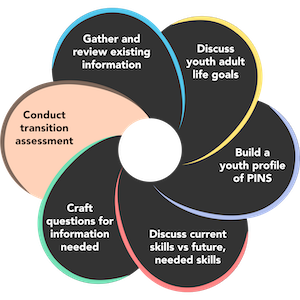Age-Appropriate Transition Assessment Planning Guide
Formal and Informal Tools
There are two basic categories for assessment:
- Formal: Formal assessments are standardized instruments that include descriptions of their norming process, reliability and validity, and recommended uses (NTACT, 2016).
- Informal: Informal assessments generally provide descriptive individual information but lack formal norming procedures.
Some transition assessment questions will require a formal tool be used to gather the needed data. For example, a question that seeks to understand the student's competencies for a particular industry standard may best be answered by using an industry exam. However, questions about how the youth may react to social challenges may best be answered through observations of authentic social situations. It does not mean informal assessments are less structured or planned than formal assessments. Rather, informal assessments help us know more personal information about youth.

There are no requirements to use a certain number of formal or informal assessments. The transition assessment planning process focuses on the questions needing answered - and not inherently the assessment that helps us find the answer.
| Examples of Informal Assessment Measures | |
|---|---|
| Interviews, questionnaires & surveys | Structured observation |
| Anecdotal records | Environmental/ situational analysis |
| Curriculum based assessments | Preferences assessments checklists |
| Interest inventories | Transition planning inventories |
| Community or work-based observations | Simulations |
| Demonstrations | Student Products |
| Examples of Formal Assessment Measures | |
|---|---|
| Adaptive Behavior Scales | Independent living assessments |
| Aptitude Tests | Career/Vocational assessment |
| Interest assessments | Achievement Tests |
| Personality/ Preference profiles | Occupational skill assessments |
| Work task or training evaluations | Classroom content tests and/or work samples |
| Standardized tests | Trade and industry exams (in Ohio, WebXams) |
